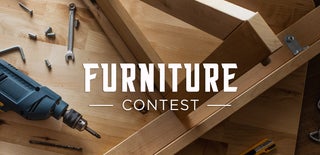Introduction: Speaker End Table
Almost one year ago I built my first piece of "fine" furniture (at least for me). It was an end table made from solid walnut with traditional joinery. One of the ideas was to have a removable drawer that I could replace with a Bluetooth speaker. Well after a year that idea is a reality!
Tools & Materials
Step 1: Cut Down the MDF Box
The main speaker is built from 3/4in MDF. This is cut from a sheet down to a strip on the table saw. It is then cut to width on the miter saw.
Step 2: Cut the MDF Strips at an Angle
Using an angle gauge the table is set up to cut at a 45 degree angle. All four sides of the box are cut on the table saw.
Step 3: Glue the Box Assembly Together
The box is glued together by first laying all the pieces upside down on a work surface. I then added glue and folded the pieces together. The box was secured with tape and clamps while the wood glue dried.
Step 4: Spray Paint the Box Black
The box body is spray painted black on all sides.
Step 5: Prepare the Walnut Front Face
The front face of the speaker is made from 3/4 in walnut. This was a rough cut piece so I got it flat and square on the planer and jointer. The walnut front was then cut to size on the table.
Step 6: Design the Front Face in Fusion 360
This step could be skipped if you don’t have a CNC but I wanted to create a unique 3D design. I used Fusion 360 to mimic the effect of water rippling from the speaker's face.
Also since I didn’t have a large enough bit to cut out the speaker holes these were designed into the model as well.
Step 7: Cut the Front Face on a CNC
The front face was cut in two different passes. The first was an adaptive facing operation using a 1/4 in uncut bit. The second operation refined and smoothed the design using a ball noise bit.
Step 8: Wire Up the Electronics
So I won’t go into great detail here on the wiring on the electronics. I bought a speaker kit from Kirby at Kirby Meets Audio. I’m using his Fawn speaker plans and speaker kit. He provides great plans to put it all together.
But a quick overview….
Step 9: Attach the Woofer and Tweet to the Front Face.
The subwoofer is screwed into the speaker face. The tweeter can be friction fit into place. This could also be secured with super glue.
Step 10: Wire Up the Crossover
These plans include a passive crossover design. The basic idea is that through inducers, resistors and capacitors you can split the audio signal for your different sized speakers. These parts were soldered together and I used heat shrink and electrical tape to secure all the joints
Finally, attach the volume knob to the front face
Step 11: Cut Out the Speaker Back
The back is cut from a piece of MDF and painted black. I used a CNC to cut a hole large enough for the speaker out ports.
The back electronics are screwed into place. They include a power port, 1/16 audio jack and power switch.
Step 12: Drill Rear Components
Holes were drilled for the rear components with their appropriate sized bits. I then used a Forstner bit to remove materials around those holes from the back so that the electronics could fit into place.
Step 13: Secure Soundboard Into Place
I didn’t have any spacer on hand so I secured the soundboard directly to the back of the speaker back. I plan to go back and insulate this later but for not it is seeming to work.
Step 14: Finish the Front Face
This step should have been done before I wired up the electronics. I was able to remove them enough so I could oil the front speaker’s surface. I used a few coats of Generals Arm-R-Seal. Then for the speaker body, I used a several coats of shellac.
Step 15: Glue the Front Face
Wood glue was used to attach the front face to the speaker box. This was clamped into place so that it could dry.
Step 16: Attach the Back Panel
The back panel is attached with countersunk screws. This allows me to open the speaker up if anything ever needs to be repaired or modified in the future.
Step 17: Adjust the Reveal of the Speaker
Step 18: That’s It!
And that’s it! I’ve been using an Amazon Echo with the speaker it is working great!

Grand Prize in the
Furniture Contest













